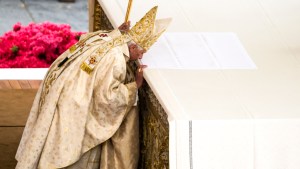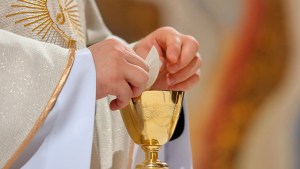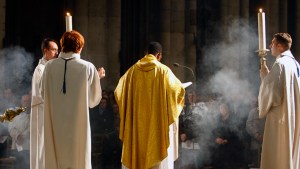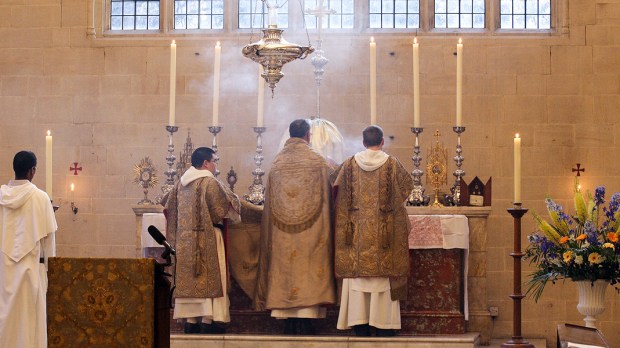A little-known detail in Catholic Churches is the presence of saint relics inside the primary altar reserved for the sacrifice of the Mass. These relics are generally encased inside an altar stone, though sometimes they can be visibly displayed in special reliquaries.
It is an ancient custom that the Church retains, as specified by the General Instruction of the Roman Missal, “The practice of the deposition of relics of Saints, even those not Martyrs, under the altar to be dedicated is fittingly retained. However, care should be taken to ensure the authenticity of such relics.”
Why does the Catholic Church do this?
Nikolaus Gihr, in his Holy Sacrifice of the Mass, gives a brief history of this custom.
The ordinance of Pope Felix I. (about 270), to celebrate the Holy Sacrifice of the Mass “over the tombs of the martyrs,” merely confirmed a long existing custom. Later on the remains of the saints were transferred from their place of burial and placed in the interior of newly erected altars. The place in which the martyrs were interred, that is, the altar built over their tomb and also the church which enclosed it, were usually called confessio (tuapripuiv, place of confession) or memoria (memorial).

Read more:
This is why the priest kisses the altar at Mass
It was common for the early Christians to celebrate memorial Masses in the catacombs, on top of the tombs of the saints. This practice was continued, when churches were built, by transferring relics of the saints to the altar.
Interestingly enough, there is a passage in the Bible that prophetically refers to this practice.
I saw underneath the altar the souls of those who had been slaughtered because of the witness they bore to the word of God. (Revelation 6:9)
In this sense, the practice of placing relics underneath the altar is entirely biblical. It is not meant to take anything away from our focus on Jesus Christ and his sacrifice on Calvary, but to remind us of how we are to imitate his example.
Gihr expands on this symbolism, explaining a little more of how the celebration of Mass on the top of saints’ relics is meant to be a powerful spiritual sign.
It is profoundly significant. For they who sacrificed their lives and gloriously shed their blood for Christ, should rest at the foot of the altar, whereon is celebrated Christ’s Sacrifice that infused into them the heroism and the strength of martyrdom. The entombing of martyrs in or under the altar designates their close resemblance to the Lamb of God, as it took place in suffering and now consists in glory.When St. Ambrose discovered the bodies of the Martyrs Gervasius and Protasius, he placed them under the altar. In an animated discourse to the people, he said among other things: “The triumphal sacrifices are to be placed where the propitiatory Sacrifice of Christ is commemorated. Upon the altar is He that suffered for us all; beneath the altar are they who by His sufferings were redeemed…the martyrs are entitled to this resting place.”
This is not “saint worship,” but a strong reminder to us all of Jesus’ words to his disciples, “Whoever wishes to come after me must deny himself, take up his cross, and follow me” (Matthew 16:24). Through a life of sacrifice, some day we can join the holy ones in Heaven, “These are the ones who have survived the time of great distress; they have washed their robes and made them white in the blood of the Lamb” (Revelation 7:14).

Read more:
Why do priests drop a piece of host into the chalice?

Read more:
Why is the Gospel led by candles and incense at Mass?

